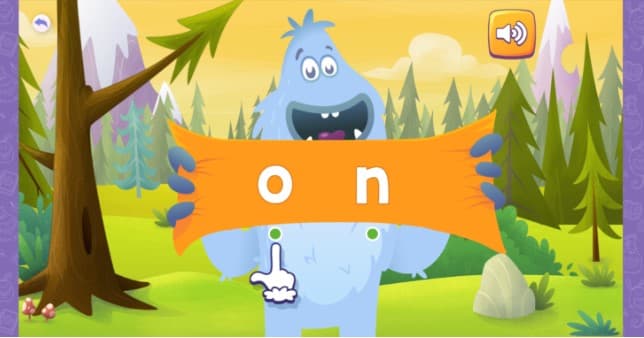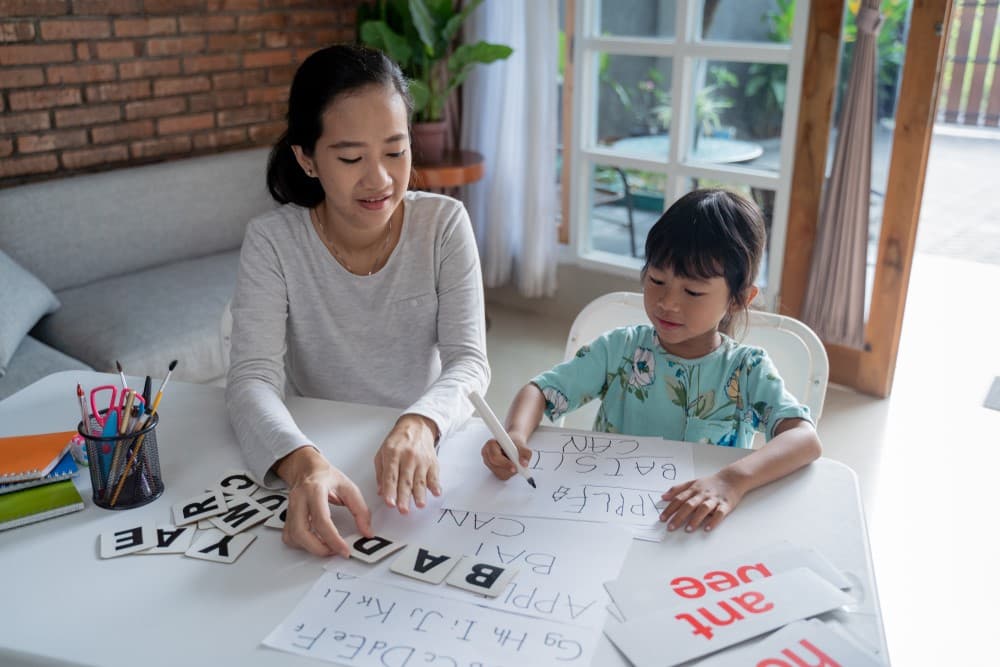


Fun Homeschool Phonics Lessons, Games and Activities

ABC Reading Eggs is packed with phonics resources for your homeschool curriculum and includes the powerful Fast Phonics program, which is a systematic synthetic phonics approach to teach children how to read. Free Trial
A key component of teaching children to read is phonics instruction. Homeschooling phonics can feel like an overwhelming task, but don’t fret! Helping your child learn phonics at home doesn’t need to be complicated or frustrating – for the student or the teacher. Particularly if we take a learning-through-play approach to help keep your child motivated and engaged.
We’ve searched high and low for the best ways to teach phonics at home, in all kinds of ways, for all kinds of learners. Think phonics lessons, phonics games and even outdoor phonics activities. From using visual aids to incorporating technology, you'll find everything you need, to give your child the solid foundation they need to become a proficient reader.
After all, one of the best parts of homeschooling is that you’re able to tailor instruction to your child's individual needs and learning style.
How to start homeschooling phonics
First up, what is phonics? Phonics focuses on the relationships between the letters (or letter combinations) of written language and the sounds of spoken language. Once children understand this, they can apply this knowledge when reading to recognise words.
Why is phonics important? Kids have a learning advantage when they are given explicit and systematic phonics instruction early on in their lives.
This is why it’s best to teach phonics skills in a clearly defined sequence, starting with straightforward, easier skills, before moving on to more complex skills.
Here’s how to begin helping your child understand phonics, followed by some fun hands-on games and activities.
1. Start with the basics – develop phonemic awareness
Teach your child the individual sounds of letters, known as phonemes. See the fun phonics games listed below for creative ideas to make learning phonics fun.
2. Introduce short vowels first
Teach your child the short vowel sounds (a, e, i, o, u) before moving on to long vowels.
3. Practise blending
Once your child is familiar with individual sounds, practise blending them together to form words.

If you’re homeschooling phonics, try the Fast Phonics program, including the Stretch It Out activity (pictured) that helps kids sound out and blend together to make words. Try all the phonics activities in Fast Phonics and ABC Reading Eggs today for free! Free trial
4. Use technology
Use online resources and apps, such as ABC Reading Eggs, to teach or supplement your homeschool phonics instruction. ABC Reading Eggs offers phonics as part of a broad approach to teaching reading that also includes phonemic awareness, fluency, vocabulary, and comprehension.
Packed with homeschool friendly resources, including the helpful placement test that gives insight into where your child needs to begin and reporting features that keep you informed on their progress. Children also love the Reading Journal, where they can list all the decodable books they’ve read. These are a huge help for phonics instruction.
Included in ABC Reading Eggs suite of programs is Fast Phonics, which has a purely synthetic, systematic approach to phonics.
Try Fast Phonics and ABC Reading Eggs for FREE!
Fast Phonics is ABC Reading Eggs' online synthetic phonics program. Based on solid scientific research, Fast Phonics uses the proven power of systematic phonics instruction to boost kids’ reading skills fast! With 20 fun‑filled levels to give your child an understanding of key phonics skills including letter‑sound recognition, blending and spelling. Start your 30-day free trial today!
Fast Phonics is ideal for children just learning to read (aged 5–10) or older kids who are struggling at school. It is packed with highly engaging phonics games and motivating rewards to keep children on track and wanting to improve their skills. Also, don't forget to check out ABC Reading Eggs's comprehensive homeschool curriculum guide that helps parents follow a sequence of activities and lessons.
5. Read aloud
Read aloud to your child regularly and point out the sounds and letters as you read. Snuggle up with a book they love for some quality, cosy reading time.
6. Use visual aids
Flashcards, letter blocks and other visual aids can help your child associate letters with sounds.
7. Incorporate movement
Encourage your child to move their body while learning sounds, such as jumping or clapping as they say a sound. Make it fun!
Watch our video to discover ABC Reading Eggs expert Sara Leman’s top tips for teaching children phonics at home.
8. Incorporate writing
Have your child practise writing the letters and words they are learning. If they get sick of pencil and paper, shaving cream on a shower screen is always a winner. The ABC Reading Eggs app also offers letters that children can trace on their iPad, with matching sounds to boot!
9. Be consistent
Incorporate phonics instruction into your daily homeschool routine and be consistent in your teaching approach. Repetition will help your child grasp their sounds and letters.
10. Phonics bingo
Create a bingo board with words that contain a specific sound or group of sounds. Get your child to seek them out and mark them as you call them out.

The interactive, one-on-one instructional phonics lessons in ABC Reading Eggs have an explicit focus on phonics. Skills are reinforced with carefully designed activities to make homeschooling phonics fun and engaging. Free trial
Creative homeschool phonics lessons
11. Sound scavenger hunt
Create a list of words that have a particular sound and have your child search for them in books, magazines, or around the house.
12. Rhyme time
Play this rhyming game, where you come up with a word and get your child to say a word that rhymes with it. This will help them to identify and practise the ending sounds. Encourage your child to keep it going as long as they can and praise their efforts.
13. Build-a-word
Get the letter blocks out or cut-out letters to have your child build words and practise blending sounds together.
14. Sound matching
Create your very own homeschool set of cards with pictures and words on them and have your child match the pictures to the corresponding words.
15. Word families
Make word families by changing the initial sound of a word. Then get your child to practise reading and writing words within that word family. Practice makes perfect!
16. I Spy the sound
Certain games are a classic for good reason and this is no exception! Best of all, you can play this game anywhere. Change it slightly to "I spy a word beginning with 'a'", and demonstrate that it sounds like “ahh”.
Benefits of teaching phonics at home
A wonderful part of homeschooling is being able to switch it up when your child isn’t responding well to a lesson. Why not take your phonics lessons outdoors whenever your child needs a break from sitting down, learning inside? Try these homeschool phonics activities while you’re on the go, especially if you have a child that needs to move while learning.
17. Sound walk
Take a walk around your neighbourhood or a nearby park and have your child listen out for different sounds and letters. Have them identify words that start with a specific sound, or words that rhyme with a specific word.
18. Letter hunt
Create a list of letters or sounds for your child to find on signs, billboards, or license plates while on a drive or a walk. This is a great game to keep kids occupied on a long drive! For closer to home, why not hide letter cards around the backyard that your little one can search for?
19. Word hopscotch
Create a hopscotch board with words instead of numbers. Have your child jump on the words in order to practise blending sounds together.

20. Word picnic
Pack a picnic lunch and have your child find and read words on food packaging, cans, or bottles before eating.
21. Word graffiti
Give your child washable paint and have them write words on the sidewalk or a large piece of paper. This will help them practise writing letters and words.
22. Word obstacle course
Set up an obstacle course in your backyard or a nearby park and have your child read a word before they go through each obstacle.
These are just a few examples of fun outdoor activities that can be used to teach phonics to homeschoolers. They combine physical activity and learning, in a way that children enjoy, and isn’t that the best way to retain information? Remember to be flexible and adapt these activities to your child's interests, learning style and your homeschool goals.
So, with patience, consistency and a healthy dose of creativity, homeschoolers can be instrumental in helping their child learn phonics and in turn become proficient readers. You know your family best, so adapt or tailor these homeschool phonics ideas to fit your child’s needs; this could depend on your child's age, what sparks their interest, or their individual learning style.
Once again, incorporating the basics of phonics instruction, such as teaching individual sounds and blending them together, using visual aids, mixing it up with movement and reading aloud, can provide a sound foundation for your child's reading skills.
Simplify teaching phonics at home with ABC Reading Eggs
ABC Reading Eggs' comprehensive online curriculum makes the perfect resource for homeschooling phonics. Use the placement test to ensure your child starts at the right level and reporting features like time on task to see the average time your child spends on each activity. Children also love the Reading Journal, where they can list all the decodable books they’ve read. These are a huge help for phonics instruction. Start your 30-day free trial today!
Making the most of online learn-to-read resources and programs like ABC Reading Eggs, supplements and enhances the homeschool phonics learning experience. Overall, we hope that teaching phonics at home with our program and the ideas above, is a rewarding experience for both homeschoolers and their children, as it can lead to a lifelong love of reading and learning.
Check out more homeschool testimonials to see how the program has worked for other children that are homeschooled.






